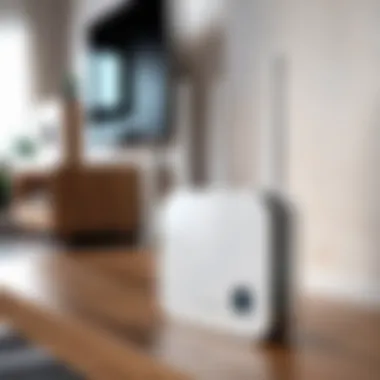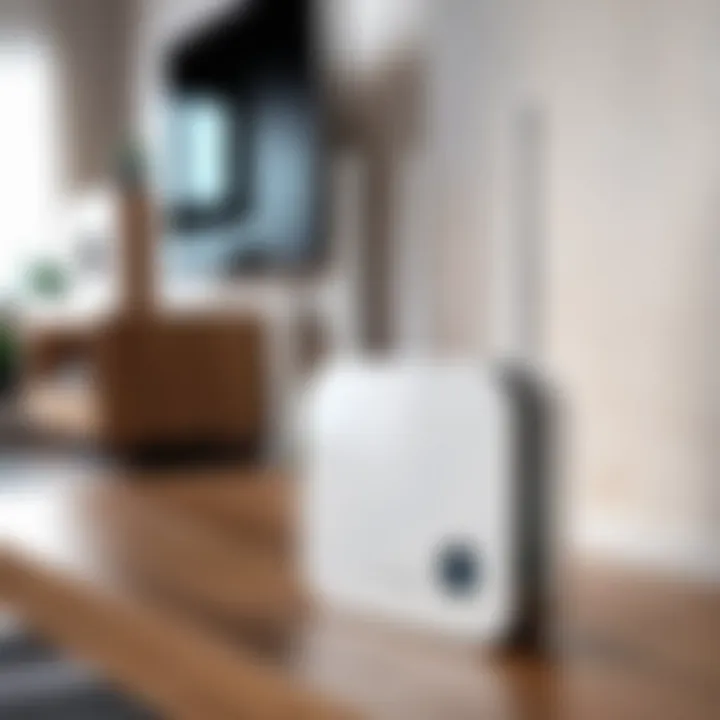Exploring the Operational Range of WiFi Extenders


Intro
In the modern era of connectivity, the necessity for reliable WiFi coverage has become a fundamental aspect of both personal and professional environments. WiFi extenders serve as a popular solution for enhancing and expanding network coverage, but many potential users remain unaware of how they function and what factors impact their performance. Understanding the operational range of WiFi extenders is essential for optimizing coverage in various settings, especially in homes and offices with challenging layouts.
This comprehensive guide will explore the key dimensions of WiFi extenders, how they work, and the limitations imposed by the physical environment. Moreover, we will examine the various types of extenders available on the market, establish best practices for installation, and offer alternative approaches to bolster signal strength. Whether you are a tech enthusiast or an IT professional, familiarizing yourself with the intricacies of WiFi extenders is vital for maximizing your network’s potential.
Foreword to WiFi Extenders
The prevalence of wireless devices in homes and offices makes understanding the role of WiFi extenders essential. With a growing need for robust internet connectivity, WiFi extenders provide a solution to dead zones and weak signals. In urban settings and larger spaces, the signal from a main router may not reach every corner. Here, WiFi extenders play a crucial role by amplifying and redistributing the network signal, ensuring that users enjoy a reliable connection throughout their environment.
Benefits of using WiFi extenders include enhanced coverage, improved browsing experiences, and the ability to connect multiple devices without degrading performance. Knowing how these devices function and their limitations will help users make informed decisions. Additionally, considering which type of extender suits specific needs is vital. This will influence setup and ultimately extend WiFi reach effectively.
Factors such as placement, interference, and physical obstructions should be examined closely for optimal performance. Understanding these elements will be a central focus of this article, guiding users through the technical landscape of WiFi extenders.
Definition and Purpose
WiFi extenders, also known as repeaters or boosters, are devices designed to expand the coverage area of a wireless network. They receive the existing WiFi signal and rebroadcast it, aiding in eliminating dead zones where connectivity is weak or nonexistent. The core purpose is simple: to ensure consistent internet access across larger areas or spaces with obstacles that disrupt signals, such as walls or furniture.
In practical terms, consider a two-story home. The router might be on the first floor, resulting in poor connectivity on the second. A WiFi extender can be placed strategically on the staircase to catch the signal and relay it to the upper levels. This extends the effective coverage without necessitating complex installations or additional wiring.
Types of WiFi Extenders
Several types of WiFi extenders exist, each catering to different requirements and environments.
- Range Extenders: These are basic models that amplify the signal coming from the router. They are generally easy to install, making them suitable for casual users.
- Powerline Adapters: Utilizing existing electrical wiring in a building, these adapters extend the network. They often deliver faster speeds compared to basic range extenders, especially in larger homes.
- Mesh WiFi Systems: Though not traditional extenders, mesh systems comprise multiple nodes that communicate to provide seamless coverage throughout the premises. They represent a more integrated approach to network coverage.
- Wireless Repeaters: Similar to standard range extenders but often incorporate advance technologies like dual-band, allowing them to operate on two frequency bands. This leads to better performance under varying network demands.
In summary, selecting a suitable WiFi extender involves understanding the environment and specific needs. Each type has its strengths and weaknesses, which will be elaborated upon in subsequent sections.
Understanding WiFi Signals
Understanding WiFi signals is essential to optimizing the use of WiFi extenders. It creates a foundation for grasping how these devices function and their limitations. The signals transmitted by WiFi networks can vary significantly based on several factors, including frequency bands, environmental elements, and overall network configuration. A thorough understanding of these signals leads to better decisions about equipment purchases, placement, and network management.
WiFi Frequency Bands
WiFi operates primarily within two frequency bands: 2.4 GHz and 5 GHz. Each band has distinct characteristics affecting their performance and range.
- 2.4 GHz Band: This band has a longer range and better penetration through walls and obstacles. It can reach areas where 5 GHz signals may not, making it useful in larger homes. However, it often experiences more interference from common household devices such as microwaves and cordless phones. Its bandwidth is limited, leading to potential congestion when multiple devices connect.
- 5 GHz Band: The 5 GHz band offers higher speeds and less interference, making it ideal for bandwidth-heavy activities like streaming and gaming. However, its signals do not travel as far as the 2.4 GHz band and struggle to penetrate solid objects. Thus, using this frequency can lead to dead zones if not properly configured and installed.
Understanding the differences between these bands is crucial for choosing the right settings on a WiFi extender. By examining network requirements, users can select which band to utilize for specific devices, ensuring optimal performance and coverage.
Signal Strength and Quality
Signal strength and quality are critical elements when assessing the performance of a WiFi extender. Even if a device connects to a network, the strength of its signal significantly influences speed and reliability.
- Signal Strength: Refers to the power level of the WiFi signal reaching a device. Measured in decibels (dBm), signal strength impacts how well devices can communicate with the router or extender. A stronger signal generally results in faster data transmission.
- Signal Quality: Encompasses several factors, including interference, noise, and the overall clarity of the signal. Even with adequate strength, poor signal quality can lead to dropped connections and slower speeds.
To enhance signal strength and quality, a few best practices can be applied:
- Positioning the Extender: Place the extender in a location that gets a good signal from the router. Ideally, it should be halfway between the router and the area needing coverage.
- Avoiding Interference: Keep the device away from metal objects and other electronics that may hinder signal pathways.
- Routine Checking: Use tools or applications to monitor signal strength and make adjustments as necessary.
Improving the signal quality requires an awareness of your environment and the technology in play.
Factors Affecting WiFi Extender Range


Physical Obstructions
Physical barriers often impede the effectiveness of WiFi extenders. Common obstructions include walls, furniture, and appliances. Dense materials like concrete or metal particularly hinder signal transmission. For example, a brick wall may drastically reduce signal strength compared to a wooden partition. The greater the number of obstacles the signal has to traverse, the more its strength diminishes.
The placement of the extender regarding the router also plays a role. If the extender is located far from the router and behind several walls, its performance can drop significantly. Users are encouraged to place extenders in open spaces, ideally at least halfway between the router and the area requiring coverage. Here are some common physical obstructions to consider:
- Concrete walls
- Metal appliances (like refrigerators)
- Large pieces of furniture
- Windows (if low-quality glass is used)
By being mindful of these factors, users can optimize their installation locations for better performance.
Interference from Other Devices
Electromagnetic interference can impair the performance of WiFi extenders. A variety of household electronics can compete with WiFi signals, causing lag or connection drops. Common culprits include microwave ovens, cordless phones, and Bluetooth devices. Each of these can operate on similar frequencies to WiFi signals, causing disruptions.
To minimize interference, it is beneficial to keep the extender away from these devices. Users can also experiment with different WiFi channels on their routers. Many routers include options to switch frequency bands, such as 2.4 GHz versus 5 GHz. The latter typically experiences less interference but may have a shorter range. Thus, finding the optimal channel can greatly enhance overall performance.
Placement and Installation Considerations
The correct placement of a WiFi extender impacts its ability to extend coverage effectively. Simply having an extender is not enough. Strategic installation can differentiate between a poorly functioning network and a robust, seamless experience throughout your home or office.
When installing, certain points should be noted:
- Ensure the extender is within the range of the original router's signal.
- Use the extender in areas where the WiFi signal is weak but still reachable.
- Avoid placing the extender in concealed areas like inside cabinets to promote better signal distribution.
- Consider utilizing network mapping tools to visualize signal strength and optimize location further.
Installing a WiFi extender correctly will not only enhance signal range but also ensure consistent performance across different devices.
The efficiency of a WiFi extender relies on understanding and mitigating physical barriers, interference, and strategic placement.
Real-world Extender Range
Understanding the real-world range of WiFi extenders is essential for anyone looking to enhance their wireless coverage. While theoretical specifications provide a baseline, the actual performance can differ significantly based on various factors. This section will explore why real-world range matters and what it means for users in practical scenarios.
Often users purchase extenders expecting them to extend the network's reach as described by manufacturers. However, environmental variables play a critical role in the actual performance. Users must account for walls, flooring, and even furniture, all of which absorb or deflect signals. The range’s measurement is not just about what a device can potentially cover, but about how it performs within the specific context of a user’s home or office.
Knowing the real-world range helps in making informed purchase decisions. Factors like signal strength, latency, and consistency of service can significantly affect user experience. Understanding these elements leads to better choices in selecting and configuring a WiFi extender.
"Understanding the actual range of a WiFi extender is vital, not just for installation but also for ensuring a seamless connectivity experience."
Manufacturer Specifications
Manufacturer specifications often indicate a theoretical maximum range under optimal conditions. Example products such as the TP-Link RE650 advertise a range up to 2600 square feet. However, this does not consider obstacles or interference present in most environments.
The two main specifications to pay attention to are:
- Coverage Area: This indicates how far the extender can reach theoretically without barriers.
- Signal Strength: Measured in decibels (dBm), this indicates how strong the signal will be at various distances. A higher dBm means a stronger signal, though many factors can reduce this strength over distance.
It is important to read the specifications critically and consider them as guidelines rather than absolute truths.
Actual Performance Metrics
Actual performance metrics are essential for assessing the effectiveness of a WiFi extender beyond manufacturer claims. Evaluating these metrics can reveal performance in real life and guide users towards better experiences. Some key metrics to analyze include:
- Throughput: This measures the data transfer rate and helps users understand how quickly data can travel through the extender. A typical home user would want at least 30 Mbps for video streaming.
- Latency: This is the time taken for data to travel from one device to another. High latency can lead to lags, impacting gaming or video calls.


In practical tests, users often find that extenders perform better in specific rooms while facing degradation in others due to simple layout or interference from other electronic devices.
Conducting real-life tests before and after installation is advisable. Users should perform speed tests at various distances from the extender in the home as well as compare performance metrics against those advertised by the manufacturer.
Optimizing WiFi Extender Performance
Optimizing the performance of WiFi extenders is critical for achieving consistent and reliable internet connectivity across a given area. Despite their function, extenders often underperform if not configured or maintained properly. This section delves into practical strategies to maximize the effectiveness of these devices, focusing on configuration and regular software updates. The right approach can lead to improved signal strength, reduced latency, and a better overall user experience.
Configuration Tips
Effective configuration of a WiFi extender is essential for ensuring optimal performance. Here are key vints to consider:
- Placement of the Extender: Position the extender halfway between the router and the area where coverage is needed. This ensures it receives a strong signal while also stretching its range further.
- Connection Type: Use a wired Ethernet connection whenever possible. Connecting extenders offline results in faster speeds compared to relying solely on wireless connectivity.
- SSID and Password Settings: If the extender has its own network name (SSID), consider keeping it the same as the router's. This can make devices automatically connect without disruption as users move through the space.
- Channel Selection: Manually selecting channels can often increase speed and reduce interference. Use tools or software that help identify the least crowded channels x.
- Security Settings: Ensure that WPA3 or WPA2 security protocols are in place. This not only provides a secure connection but can affect performance.
By following these configuration tips, users can significantly enhance their WiFi extender's performance and network reliability.
Software and Firmware Updates
Regularly updating the software and firmware of a WiFi extender is vital for maintaining its performance. Manufacturers frequently release updates to address bugs, improve functionality, and enhance security. Here are some important aspects to consider:
- Checking for Updates: Most devices have an option to check for software updates within their settings menu. Make it a habit to check for updates periodically.
- Automated Updates: Enable automated updates, if available. This feature ensures that your extender is always running the latest version without the need for manual intervention.
- Reading Release Notes: Before implementing updates, review the release notes provided by the manufacturer. This information often includes details about improvements or fixes relevant to the user experience.
- Rebooting After Updates: After an update, reboot the extender to apply changes properly. This is an important step that can help clear any potential cache issues.
Keeping the firmware up to date can reduce vulnerabilities, improve stability, and enhance the overall performance of WiFi extenders.
"Maintaining an updated system becomes a cornerstone of network reliability and efficiency."
Challenges with WiFi Extenders
The deployment of WiFi extenders offers numerous advantages for improving network coverage. However, certain challenges must be acknowledged. These issues can profoundly impact performance, leading to dissatisfaction among users. Understanding these challenges is essential for optimizing the use of WiFi extenders, particularly for IT professionals and tech enthusiasts. This section will address two principal challenges: latency and speed reduction, as well as compatibility with existing hardware.
Latency and Speed Reduction
Latency is a crucial aspect when considering WiFi extenders. This term refers to the delay in data transmission. In simpler terms, it is the time taken for a data packet to travel from its source to its destination and back again. WiFi extenders typically introduce additional latency into the network. Each time a signal must be relayed, there is an inherent delay.
- Signal Relay: When using an extender, the device must receive the signal from the router and then send it to the connected client. This relaying process inherently increases the response time.
- Bandwidth Sharing: Furthermore, extenders usually share bandwidth between clients and their main router. This can lead to a reduction in available speed for each connected device. Consequently, users may experience greater delays with tasks requiring high-speed connections, such as gaming or streaming.
While WiFi extenders are effective in extending range, often performance comes at a compromise. It is critical for users to measure their specific needs and evaluate whether the extender's inherent latency aligns with their requirements.
In environments where speed is critical, consider direct connections over extenders for optimal performance.
Compatibility with Existing Hardware
Another significant challenge involves the compatibility of WiFi extenders with current networking equipment. Numerous WiFi technologies exist, and not all devices communicate effectively with one another. This can lead to several operational issues:
- Outdated Standards: Older routers may not fully support modern extenders, leading to underutilized technology. For instance, if a newer extender operates on the WiFi 6 standard, while the router uses WiFi 4, this mismatch could limit performance potentials.
- Firmware Conflicts: Regular updates are essential for maintaining good performance. Compatibility issues may arise when extenders and routers run different firmware versions, leading to connection drops or inadequate coverage.
- Device Limitations: Many extenders can only manage a limited number of connections. If too many devices are connected, users may experience slowdowns, frustrating the typical user experience.
Alternatives to WiFi Extenders
WiFi extenders provide a simple solution for improving connectivity in large spaces or areas with weak signal strength. However, they are not the only option available to enhance network coverage. Understanding alternatives to WiFi extenders is vital for users seeking optimal performance from their networks. Each alternative comes with unique benefits and considerations that should be evaluated based on the specific needs of the user and their environment.
Mesh WiFi Systems
A mesh WiFi system comprises multiple interconnected access points that create a unified network. Unlike extenders, which rebroadcast a single signal, mesh networks distribute a more consistent signal across your home or office. They work seamlessly to eliminate dead spots and provide better coverage.


Benefits:
- Unified Network: Mesh systems offer a single network name, making it easier to connect devices without switching networks.
- Scalability: You can add more nodes to the network as needed, accommodating larger areas without losing performance.
- Intelligent Routing: Many systems automatically route data through the fastest path available, reducing latency and improving speed.
Considerations:
- Initial Cost: Mesh systems can be more expensive than basic extenders, often necessitating a larger financial investment upfront.
- Setup Complexity: While many manufacturers provide user-friendly apps, the initial setup might involve additional configuration steps compared to plug-and-play extenders.
Powerline Adapters
Powerline adapters utilize existing electrical wiring to transmit data, making them a practical solution for extending network coverage. They convert the internet signal into a power signal that travels through your home's electrical circuit.
Benefits:
- Stable Connection: Powerline adapters tend to offer more stable connections than WiFi extenders, especially in environments with heavy obstructions.
- Ease of Use: Setting up powerline adapters is simple; just plug them into a power outlet and connect them to your router and device respectively.
- No Need for New Wiring: They eliminate the need for running new Ethernet cables between rooms, which can be costly and time-consuming.
Considerations:
- Electrical Interference: The performance can vary based on the quality of the electrical wiring and interference from other devices plugged into the same circuit.
- Distance Limitations: The effectiveness may diminish significantly over longer distances or in homes with older wiring.
Upgrading Router Equipment
In some cases, upgrading router equipment can provide a more effective long-term solution than adding extenders or alternative systems. New routers often come with advanced features and improved technology to enhance performance.
Benefits:
- Improved Performance: Modern routers often support the latest WiFi standards, which can increase speed and capacity for connected devices.
- Greater Range: Many newer models are designed to cover larger areas more effectively, reducing the need for extenders.
- Enhanced Security Features: Upgrading equipment can offer better encryption and security protocols to protect your data.
Considerations:
- Cost: Upgrading can be pricey, especially for high-end models designed for demanding environments.
- Compatibility Issues: Older devices may not support the new protocols and features, potentially limiting the overall benefit.
"Choosing the right alternative for WiFi extenders involves assessing your specific needs, understanding the different technologies available, and considering the implications of implementation."
In summary, while WiFi extenders serve their purpose, exploring alternatives like mesh WiFi systems, powerline adapters, and upgrading router equipment can lead to improved performance and user satisfaction. These solutions can effectively meet varied connectivity demands and address specific challenges present in different environments.
Finale
The conclusion of this article emphasizes the pivotal role of understanding WiFi extenders and their operational range. WiFi extenders are crucial tools in enhancing connectivity in environments where signal strength is inadequate. Recognizing their capabilities and limitations helps users leverage these devices more efficiently. As users, understanding how a variety of factors—from physical barriers to technological advancements—affect the performance of extenders is essential.
One significant element discussed is the varied range capabilities of different extenders. Users need to be aware of what their specific environment requires and which model will be most effective. This insight aids in selecting the right extender, ensuring optimal WiFi coverage throughout a home or office. With this knowledge, users can expect to maintain stable internet connections, boosting productivity and overall experience.
The benefits of proper installation and configuration cannot be overstated. Many users see enhancements in their network performance merely by adhering to recommended guidelines. Furthermore, recognizing alternative solutions, such as mesh networks and powerline adapters, equips users to make informed choices when a single extender does not meet their needs. Future considerations in WiFi technology, as discussed, offer insights into ongoing advancements to address potential signal issues, indicating that the landscape of wireless connectivity will continue to evolve.
"In comprehending the operational range and functionalities of WiFi extenders, users can significantly improve their home and work environments, enhancing their online experiences."
Summary of Key Points
- WiFi extenders enhance network coverage and connectivity.
- Factors such as physical obstacles and interference affect signal quality.
- Choosing the right extender based on user needs is crucial for optimal performance.
- Proper installation and placement can significantly impact effectiveness.
- Alternative solutions like mesh systems may provide better connectivity in complex environments.
Future Considerations in WiFi Technology
The landscape of WiFi technology is constantly advancing, and the implications of these changes are crucial for users. As Internet of Things (IoT) devices proliferate, the demand for reliable and robust WiFi networks will grow. Future technologies may focus on improving signal range and strength through innovative hardware, adaptive algorithms, and artificial intelligence.
With advancements like WiFi 6 and the anticipated WiFi 7, we may see enhancements that dramatically improve performance. These standards may address congestion issues, thereby catering to multiple devices operating simultaneously.
Users should also consider how home automation trends impact their WiFi needs. Investing in dual-band or tri-band extenders may become standard practice for those utilizing smart homes. Staying informed about the latest technologies will enable users to adapt their systems accordingly, ensuring seamless connectivity for years to come.
In summary, the evolution of WiFi technology and extenders represents an ongoing journey towards more effective communication tools. Users must remain aware of these changes to keep their networks efficient and reliable.



